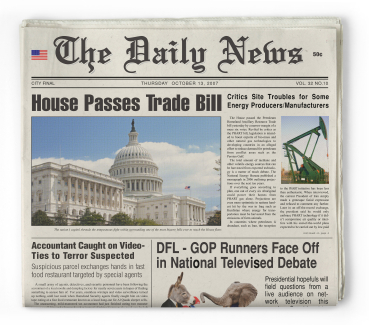How to Capitalise Book Titles and Blog Headlines
This is a post I’ve been meaning to write for a while. I find that between tending to my very active toddler and all the other distractions in my life, I don’t tend to follow the ‘rules’ always when writing on my blog. So I thought I would do a bit of continuing professional development eheheh and remind myself what the rules are with regards to How to Capitalise Book Titles and Blog Headlines.
I found this article on YourDictionary.com, so decided to share it with you. No need to keep a good thing to myself eh 😉

Style Guides
The rules for capitalizing titles not only of articles, but also books, papers, speeches, etc, can vary according to a particular style guide, such as Associated Press Stylebook (AP), Chicago Manual of Style, and MLA style. This is known as title case. While you will find similarities between each guide, it’s important to pay attention to their differences.
Style guide similarities:
- In all three styles, always capitalize the first and last word of any title.
- How to Land Your Dream Job
- In all three styles, capitalize nouns, pronouns, verbs, adjectives, and adverbs.
- Visiting Beautiful Ruins (noun)
- As She Ran Away (pronoun)
- The Importance of Learning Fast (verb)
- The Poky Little Puppy (adjective)
- She Quietly Waits (adverb)
- In all three styles, do not capitalize articles, prepositions, or coordinating conjunctions.
- To Catch a Thief (article)
- One Year in Paris (preposition)
- Magic and Daybreak (coordinating conjunction)
Style guide differences:
- In the AP Stylebook, all words with three letters or less are lowercased. However, if any of those words are verbs (is, are, was, be), they are to be capitalized.
- In the Chicago Manual of Style, all prepositions are lowercased, even the lengthier ones (between, among, throughout).
- In MLA style, words with three letters or less are always lowercased.
So, which one should you choose? Well, it all depends if a certain style is required by your teacher, course, or subject/field. For example, MLA style is commonly used in the liberal arts or humanities. AP style is popularly used in journalism, Chicago is often used in business. A suggestion is to choose one style, or check to see what style is required by your teacher or editor, and stick to it.
The General Rules for Title Case
As we can see, there are some exceptions to the general rules for title case set forth by each style guide, but they mostly follow a similar pattern. We know to capitalize the first, last, and important words in a title. Important words include nouns, pronouns, verbs, adverbs, and more. So, generally, these parts of speech are capitalized in titles:
- Nouns – man, bus, book
- Adjectives – angry, lovely, small
- Verbs – run, eat, sleep
- Adverbs – slowly, quickly, quietly
- Pronouns – he, she, it
- Subordinating conjunctions – as, because, that
“Short” words, those with less than five letters, are lowercase in titles, unless they are the first or last words. Generally, we do not capitalize:
- Articles – a, an, the
- Coordinating Conjunctions (fewer than five letters) – and, but, or, for, nor, etc.
- Prepositions (fewer than five letters) – on, at, to, from, by, etc.
When in doubt and you do not have a reference guide in front of you, here is one general rule recommended by The U.S. Government Printing Office Style Manual:
“Capitalize all words in titles of publications and documents, except a, an, the, at, by, for, in, of, on, to, up, and, as, but, or, and nor.”
What About Sentence Case?
Now that we know some of the ins and outs of title case, let’s take a look at sentence case. In sentence case, the title is written as if it is a sentence. This is considered a more casual style and is commonly used in newspapers and on the web.
Only the first word has a capital letter:
- Budget wedding invitations
- Best technology blogs
However, proper nouns within the title are also capitalized:
- Top 10 things to do in Paris
- Hiking at the Grand Canyon
Whether you’re writing in title case or sentence case, every style guide is just a little bit different. You might discover that some publications are moving toward sentence case. There are a couple reasons why writers choose this over title case.
First, one could argue that capitalized words slow down a reader’s ability to scan. A title written in sentence case could be perceived as having an uninterrupted flow. Next, some publications prefer this style simply because it’s more likely to preserve consistency. With sentence case, there’s no nitpicking over the capitalization of a three-letter preposition.
You might notice an overall trend toward this style. Many heavy hitters in the publishing industry use sentence case, including The Boston Globe, LA Times, and USA Today. However, if you pick up a copy of The New York Times, you’ll see they stick with Title Case.
Advanced Rules to Note
One of the beautiful complexities of the English language is that, for every rule you learn, there’s probably an exception. Here are some advanced rules for title capitalization:
Hyphenated Titles
Let’s take a look at the Chicago Manual of Style’s guidelines:
- Capitalize the first element.
- Capitalize subsequent elements unless they are articles, prepositions, or coordinating conjunctions (and, but, for, or, nor).
- High-Quality Web Services
- First-Rate U.S. Lawyers
- Bed-and-Breakfast Options in Savannah
- Capitalize the second element in a hyphenated spelled-out number.
- Forty-Ninth Street Blues
- Do not capitalize the second element if the first element is a prefix that could not stand alone by itself (anti or pre).
- Anti-inflammatory Dieting
Open Compounds
An open compound comes to life when a modifying adjective is used in conjunction with a noun. This creates a new noun. Hopefully warning bells will signal in your mind, as nouns are almost always capitalized.
- Salad Dressing Recipes
- The Best Science Fiction and Fantasy of the Year
The First Word Following a Colon
Let’s take a look at both the Chicago and AP Style guidelines:
- Capitalize the first word after a colon.
- Feminine Poetry: Ten Women Writers from Around the World
- Capitalize the first word after a colon if it begins an independent clause.
- I know who you are: You are my friend
- Do not capitalize the first word after a colon if the clause cannot stand alone.
- I know who you are: nobody
Prepositions That Belong to a Phrasal Verb
Prepositions often find themselves on the ‘do not capitalize’ list. However, when a preposition becomes an important part of a phrasal verb, it does need to be capitalized.
- How to Back Up a Computer
- Turn Down the Heat to Save You Money
Following the Rules
If you are debating how to capitalize titles in research papers and articles, your professor or editor will most likely delegate a certain style. In that case, make sure you visit the handbook on that style guide’s website. There will be ample guidance and examples. Aside from that, there are a wealth of other resources and handy tools out there. As you craft your titles, pay careful attention not only to the type of word, but also the length and placement of each word.
Furthermore, no matter your personal preference, make sure you write the exact titles of books, newspapers, journals, etc. as they are written on the original document (even if they do not follow common capitalization rules).
***
So there you have it! What do you think of this post on How to Capitalise Book Titles and Blog Headlines? Did you find it as mind-boggling as I did? Please leave a comment below with your thoughts. I would also really appreciate it if you clicked on one of the social icons to share this page with your network.




